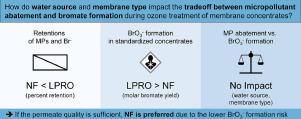Water Research ( IF 11.4 ) Pub Date : 2022-06-21 , DOI: 10.1016/j.watres.2022.118785 R Wünsch 1 , T Hettich 2 , M Prahtel 3 , M Thomann 2 , T Wintgens 4 , U von Gunten 5

|
Water treatment with nanofiltration (NF) or reverse osmosis (RO) membranes results in a purified permeate and a retentate, where solutes are concentrated and have to be properly managed and discharged. To date, little is known on how the selection of a semi-permeable dense membrane impacts the dissolved organic matter in the concentrate and what the consequences are for micropollutant (MP) abatement and bromate formation during concentrate treatment with ozone. Laboratory ozonation experiments were performed with standardized concentrates produced by three membranes (two NFs and one low-pressure reverse osmosis (LPRO) membrane) from three water sources (two river waters and one lake water). The concentrates were standardized by adjustment of pH and concentrations of dissolved organic carbon, total inorganic carbon, selected micropollutants (MP) with a low to high ozone reactivity and bromide to exclude factors which are known to impact ozonation. NF membranes had a lower retention of bromide and MPs than the LPRO membrane, and if the permeate quality of the NF membrane meets the requirements, the selection of this membrane type is beneficial due to the lower bromate formation risks upon concentrate ozonation. The bromate formation was typically higher in standardized concentrates of LPRO than of NF membranes, but the tradeoff between MP abatement and bromate formation upon ozonation of the standardized concentrates was not affected by the membrane type. Furthermore, there was no difference for the different source waters. Overall, ozonation of concentrates is only feasible for abatement of MPs with a high to moderate ozone reactivity with limited bromate formation. Differences in the DOM composition between NF and LPRO membrane concentrates are less relevant than retention of MPs and bromide by the membrane and the required ozone dose to meet a treatment target.
中文翻译:

纳滤和反渗透过程浓缩物臭氧化过程中微污染物减排和溴酸盐形成之间的权衡
使用纳滤 (NF) 或反渗透 (RO) 膜进行水处理会产生纯化的渗透物和渗余物,其中溶质被浓缩,必须妥善管理和排放。迄今为止,关于半渗透致密膜的选择如何影响精矿中溶解的有机物,以及在臭氧处理精矿期间对微污染物 (MP) 减少和溴酸盐形成的影响,我们知之甚少。使用来自三个水源(两个河水和一个湖水)的三个膜(两个 NF 和一个低压反渗透 (LPRO) 膜)生产的标准化浓缩物进行实验室臭氧化实验。通过调节溶解有机碳、总无机碳、总无机碳的 pH 值和浓度,对浓缩物进行标准化。选择具有从低到高臭氧反应性和溴化物的微污染物 (MP),以排除已知会影响臭氧化的因素。与 LPRO 膜相比,NF 膜对溴化物和 MPs 的截留率较低,如果 NF 膜的渗透质量符合要求,则选择这种膜类型是有利的,因为浓缩臭氧化时溴酸盐形成的风险较低。LPRO 标准化浓缩液中溴酸盐的形成通常高于 NF 膜,但 MP 消除和标准化浓缩液臭氧化时溴酸盐形成之间的权衡不受膜类型的影响。此外,不同的源水没有差异。全面的,浓缩物的臭氧化仅适用于减少具有高至中等臭氧反应性且溴酸盐形成有限的 MP。NF 和 LPRO 膜浓缩物之间 DOM 组成的差异与膜对 MPs 和溴化物的保留以及满足处理目标所需的臭氧剂量的相关性较小。









































 京公网安备 11010802027423号
京公网安备 11010802027423号